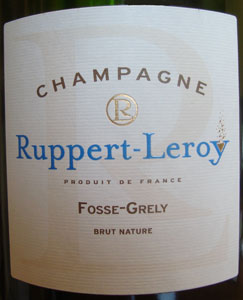Champagne Ruppert-Leroy
An exciting small biodynamic grower right on the Burgundy line
The Rare Wine Company says Ruppert-Leroy is "one of the most exciting new producers to emerge from Champagne in years. I'm about to open my first bottle - tasting notes below!
Ruppert-Leroy is in the far southeast of the Aube in far Southern Champagne, at the edge of the village of Essoyes, about 3 miles from Burgundy's famed Côte d’Or. They are really near nothing, and Essoyes with its about 750 inhabitants is best known because the painter Renoir used to summer there.
Ruppert-Leroy's story begins in the1970s when Gerard Ruppert learned he could grow grapes on his land instead of renting it for sheep grazing. He began organically farming a half hectare of vines near Essoyes. Chemicals, not organic farming, were in vogue, yet Gerald, with his PhD in philosophy, persisted and sold his grapes to the local coop.
As he was nearing retirement, his daughter, Benedict Leroy, quit her job as a physical education teacher and plunged headfirst into the Champagne business. Starting with already very healthy organic vines, Ruppert-Leroy went full biodynamic in 2009, and their first bottlings were based on the 2010 vintage. She makes the wines with her husband, Emmanuel Leroy.
They had advice from Jules Chauvet, a négociant from Beaujolais, also known as "The father of the French natural wine movement," and Pierre Overnoy from Jura, also known for his totally natural wines (now made the same way by Emmanuel Houillon who took over Pierre Overnoy’s domain, Maison Pierre Overnoy). Locally, Bertrand Gautherot of Vouette et Sorbée in Aube helped mentor them. Plenty of advice from pioneers in the natural wine movement!
They both use "traditional" organic and biodynamic techniques as well as implementing their own ideas, such as a new winery that "breathes" so the wines can breathe during aging (brick, wooden roof, wood and straw insulation), and using a very lightweight tractor to aid in transporting the grapes as benevolently, gently, and intactly as possible.
They make three wines currently, all from a single vintage from a single vineyard, and all Brut Nature, meaning no added dosage.
Ruppert-Leroy Fosse-Grely: Pinot Noir and Chardonnay from a small 2.5 hectare plot of vines planted in red limestone/clay soil (or Kimmeridgian clay if you prefer, a "calcareous clay containing Kimmeridgian limestone"). Very minerally and vinified in stainless steel.
Ruppert-Leroy Cognaux: All Pinot Noir from a miniscule 1/2 hectare plot, fermented and aged in barrels.
Ruppert-Leroy Martin-Fontaine: All Chardonnay from a 1 hectare plot, fermented and aged in barrels as is the Cognaux above.
Tasting Note: Ruppert-Leroy Martin Fontaine Brut Nature NV: January 2015, rated A- and wow!
 Unlike
the Fosse-Grely below, which was closed initially and needed time to
open up, the Martin Fontaine was open for business immediately. And like
the Fosse-Grely below, from the 2010 vintage, although not vintage dated,
and the first bottling ever.
Unlike
the Fosse-Grely below, which was closed initially and needed time to
open up, the Martin Fontaine was open for business immediately. And like
the Fosse-Grely below, from the 2010 vintage, although not vintage dated,
and the first bottling ever.
The nose is initially bread dough and grapefruit which fades quickly, revealing apple, a touch of pineapple, chalk, orange (perhaps tangerine tones in the backdrop. Very aristocratic.
Very lively on the palate with apple, lychee, maybe starfruit, and some orange tones. Apple butter. There is a lot more, but my mind is smiling too much to decipher details perhaps?
A "Wow!" wine!
 Tasting Note: Ruppert-Leroy Fosse-Grely Brut Nature NV:
December 2014, rated B+/A-
Tasting Note: Ruppert-Leroy Fosse-Grely Brut Nature NV:
December 2014, rated B+/A-
Tasted twice with consistent notes - decanted the second time.
80% Pinot Noir and 20% Chardonnay, vinifed in stainless steel. From the 2010 vintage, although not vintage dated, and the first year they bottled anything themselves!
A light straw color.
On the nose, immediate slight lemon-lime and minerals. Lots of chalk. Some orange tones. Some crisp green apple and oodles of minerals arrive after an hour of air.
The palate has clam shell and minerals. Very clean and precise. After about an hour it took on some Chablis characteristics. Also some very nice fresh yet dry apple and some orange tones.
Be very interesting to see where they go - after all, this is only their first attempt and quite impressive!
